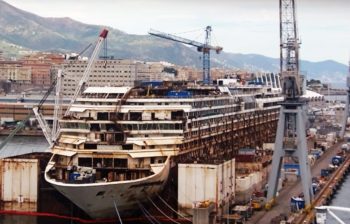
The dismantling and recycling of the infamous Costa Concordia cruise liner has been completed in Italy, marking the official end to final phase of what is considered the largest maritime salvage job in history.
The consortium responsible for the Costa Concordia’s dismantling announced the completion of the project this month in Genoa, Italy, about three years after the ship’s arrival. The consortium, known as the Ship Recycling Consortium, is made up by the Italian company Saipem, holding 51%, and San Giorgio del Porto, which held 49%.
The Costa Concordia ran aground on the Mediterranean island of Giglio on January 13, 2012 after sailing too close shore. The vessel came to rest on its side along the rock outcropping just outside the tiny island’s main harbor, prompting a massive salvage operation that lasted more than two years and involved the famous “parbuckling” operation – an event that was televised live across the globe. The cruise ship was later refloated and towed to Genoa in July 2014 for dismantling and recycling.
The Ship Recycling Consortium says that during the dismantling and recycling project, approximately 53,000 tons of materials were recycled at facilities in Italy. More than 350 workers worked nearly around the clock to dismantled the ship in a safe and environmentally-friendly
Costa Concordia’s Italian captain, Francesco Schettino, was sentenced to 16 years in jail for his role in the shipwreck, which killed 32 people. Schettino began his prison sentence this past May.
Copyright Ships & Ports Ltd. Permission to use quotations from this article is granted subject to appropriate credit given to www.shipsandports.com.ng as the source.
